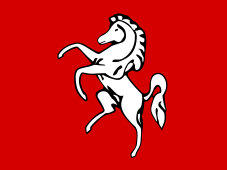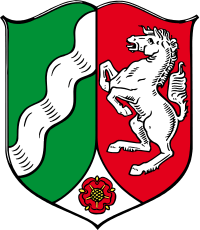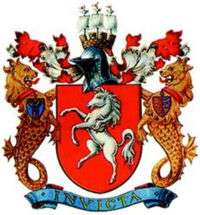White horse of Kent

The white horse of Kent, or the white horse rampant, is a symbol of Kent, a county in south-east England.[1]
The figure of the prancing (or rampant in heraldry) white horse can also be referred to as Invicta, which is the motto of Kent.[1]
Origin
The white horse of Kent is the old symbol for the Jutish Kingdom of Kent, dating from the 6th–8th century.[2]
The white horse relates to the emblem of Horsa, the brother of Hengest, who according to legend defeated the King Vortigern near Aylesford. The first recorded reference to the white horse can be found in Restitution of Decayed Antiquities from 1605 by Richard Verstegan although there is possible evidence that it was used much earlier (the White Horse Inn, Boughton-under-Blean is mentioned in the Canterbury Tales; see too the reference below to the origin of 'Invicta'). The book shows an engraving of Hengist and Horsa landing in Kent in 449 under the banner of a rampant white horse. Indeed, continental origins of this emblem can be found from the coat of arms of Lower Saxony, the Dutch region of Twente, the House of Welf (who adapted it in the late 14th century; before then the Welf coat of arms was a golden lion on red ground) and the modern German state of North Rhine-Westphalia: the Saxon Steed. Some historians note that Jutes migrating to Kent through the continent may have been associated with the Rhineland south of the Saxons. The county motto 'Invicta' (unconquered) often seen on a scroll underneath the horse dates back to the 1060s when the county was granted the right to retain its ancient symbol of the white horse and granted the motto by William the Conqueror. The story associated with this is that sometime after the Norman invasion William was ambushed in the forest that then existed outside Strood astride the London Road (the modern A2). Wiliam's escort were overpowered and he found himself at the mercy of a group of outlawed Jutish nobles. In exchange for his freedom they were pardoned and as the men of Kent had overpowered the conqueror the county was given the right to use its emblem and the new motto 'Invicta', 'Unconquered'.
-

Coat of arms of Lower Saxony, in Germany
-

Coat of arms of North Rhine-Westphalia, in Germany
-

Flag of the region of Twente, in The Netherlands
Usage
The horse is a key part of the official coat of arms of the county, and appears on the coat of arms of many of the boroughs of Kent, and even London boroughs whose areas are a part of Kent (the Jutish Kingdom), like in the coat of arms of the London Borough of Bexley and the coat of arms of the London Borough of Bromley.[3] and on the University of Kent coat of arms. The horse is depicted on the flag of Kent and forms part of the modern logos of Kent County Council, the Kent Fire and Rescue Service and the Kent Police. The horse is also depicted on the badge of Gillingham F.C., the only Kent county -based team in the Football League (Charlton Athletic FC are based in an area from the old Kingdom of Kent).
The horse also features on the logos of many companies and sports teams in Kent. It was used on the former Invictaway London commuter coaches operated by Maidstone & District Motor Services.[4][5] A large number of pubs in the county also feature White Horse in their name, although this also occurs around the United Kingdom and may not necessarily relate to the Kent horse.
-

Arms of Kent County Council
-

Coat of arms of the University of Kent
-

Logo of Kent County Council
-

Logo of the Kent Fire and Rescue Service
-

Logo of the Kent Police
See also
- Folkestone White Horse, a hill figure in Kent
- White Horse Stone, megaliths near Aylesford, Kent
- The White Horse at Ebbsfleet, a planned colossal white horse statue sculpture in Ebbsfleet, Kent
References
- 1 2 "Giant horse to become £2m artwork". BBC News. 10 February 2009. Retrieved 10 February 2009.
A prancing white horse is the logo for the county council and has been the symbol of Kent for hundreds of years. However, a sculpture of the Invicta, supported by Kent County Council in response to Mr Wallinger's entry, was rejected by judges last year.
- ↑ www.hampshireflag.co.uk Coat of Arms
- ↑ www.civicheraldry.co.uk Kent Borough Council coats of arms
- ↑ Image of a black liveried Invictaway bus
- ↑ Image of a green liveried Invictaway bus